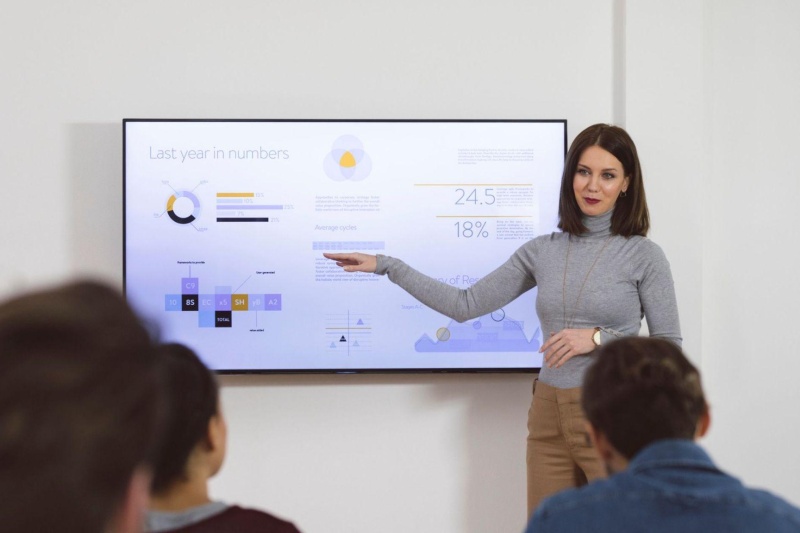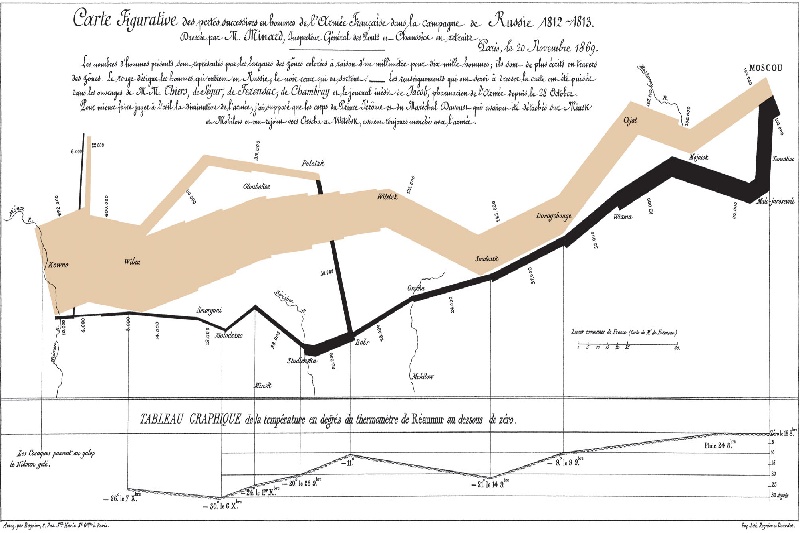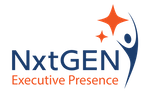As humans, our brains are hardwired to understand and respond to stories. Our ancestors used storytelling to explain complex concepts about the world and our place in it.
By visualising ourselves in the context of a narrative, we learn important life lessons about morals, actions and consequences.
Stories are just as powerful when they are used in a corporate setting. Pie charts, percentages and statistics are a useful means to organise data, but storytelling is what brings it to life and gives it meaning.
When you take your audience on an emotional journey, they are much more likely to understand, respond to and remember what you’ve said — and that is the secret to a great presentation.
Data storytelling as a powerful business tool
The goal of any presentation is to educate, persuade and inspire your audience to take action. Providing evidence in the form of data is a crucial element of a good presentation, but slide after slide of facts and figures won’t inspire anyone.
To make the data resonate with your audience, you need to make them feel something. How? By weaving the data into a compelling narrative that taps into their emotions. Presenting data without telling a story is like delivering a punchline without the joke — it lacks context and is, therefore, less impactful.
We’ve all been there – sitting in a stuffy room with a group of people, watching someone flick through PowerPoint slides, pointing at charts and reiterating the words on the screen. You don’t feel any connection to what’s being said, so you zone in and out, no matter how hard you try not to. As humans, we can’t help it. And at the end of the presentation, you can barely remember a word of it.
Now imagine you’re in a presentation where the speaker opens with a scenario that you instantly recognise. The rest of the presentation follows a familiar story structure that you can relate to. They draw you in and keep you hooked all the way through, breathing life into the facts and figures on the screen and giving them a whole new meaning.
Telling a story with your data is the difference between a boring, forgettable presentation and one that inspires your audience and stays with them long after you’ve finished speaking.

How to start storytelling with data
Storytelling is a powerful way to communicate your ideas and get your audience to take action. But how do you take your data and weave it into a story? How do you decide what to include and what to leave out?
Even if you don’t consider yourself much of a storyteller, there are tried-and-tested techniques and templates that you can use to start telling better stories with your data.
First, identify your ‘big idea’ — the one thing you want your audience to learn from or do with the data you’ll be presenting. This should be based on your audience’s needs, first and foremost.
Then, develop a basic narrative structure that supports and drives your big idea forward.
Story Templates
Here are some of the templates that are most commonly used to help place the listener in the centre of the storyteller’s tale:
1. The David and Goliath Story Template
This template is based on the familiar story of the underdog (David) defeating the likely champion (the much bigger and stronger Goliath) and is often used by leaders to inspire and motivate their team.
You can use this template in your presentations, too. The key is to help your audience see themselves as David in the story; capable of overcoming any challenge, no matter how big.
2. The Hero’s Journey
This follows a structure that will be familiar to most people. It starts with an unlikely hero embarking on an adventure filled with peril. He learns some important lessons along the way and defeats an evil adversary or overcomes an obstacle of some kind. He returns home a changed man, much wiser and happier as a result of his experience.
In the case of data presentation, the ‘hero’ of your story can be the report, statistics or the actionable insight you are aiming to impart (but it can never be you!).
The journey can be the struggle to get the data seen and understood, and the obstacle can be what is getting in the way of this data becoming reality.
3. Situation – Obstacle – Action – Result
With this story template, you can start by setting the scene for your audience, showing them the way things were and helping them to identify with the main character in the story.
Then introduce the obstacle — the thing that was standing in the way of their success — and outline the steps the character took to overcome this obstacle. Finally, show how things changed for the better as a result of taking action.
There are many other storytelling templates that you can adapt to your own needs, so don’t be afraid to experiment.

Data visualisation vs data storytelling
Data visualisation and data storytelling are two distinct but often conflated concepts, so it’s important to understand the difference.
Data Visualisation
Data visualisation is about presenting data in a visually appealing, easy-to-understand way. It helps the audience to memorise and understand the information being presented.
One famous example of data visualisation is Charles Minard’s Visualisation Of Napoleon’s 1812 March. Minard took all the information that was usually represented across several graphs and condensed it into one single graphic.
It’s an excellent example of displaying several dimensions of information in one graph while keeping distracting text to a minimum:

Data storytelling
After data is collected, processed and analysed, there is one final step: to communicate it clearly and effectively. This is what gives it meaning. Without meaning, data is merely a collection of words and numbers on a page or a screen.
Data storytelling is the next step up from data visualisation — it adds the ‘secret sauce’, which is the element of human communication. It is the bridge that makes your data accessible to your audience, helping to inspire, influence and persuade them to take action.
Tips for memorable data presentation
With the global shift towards remote working, more and more presentations are being conducted virtually. While presentations can be challenging at the best of times, the energy and participation of a live audience can help to encourage the speaker and breathe life into a presentation.
By contrast, virtual presentations lack the eye contact, body language cues and meaningful dialogue that help make a live presentation more engaging and dynamic. Whether it’s virtually or in person, the following tips will help you deliver a more effective and memorable presentation.
1. Cater to your audience
In all of the decisions we make on a daily basis, there is one question that comes first (whether we are conscious of it or not). That question is: “What’s in it for me?”.
To connect with your audience and get them to really pay attention, give them what they want. Answer their burning questions, speak to their desires, solve a problem or help them in some way. Think about what they want to hear from you and structure your presentation accordingly.
Don’t forget to make it clear what you want them to do next with a strong call to action.
2. Visually highlight crucial points in the data
What you present on the screen should serve to highlight crucial points that you want your audience to remember. Packing your slides full of text and charts can seem like the easy option, but it’s a much better idea to adopt a ‘less is more’ approach.
Include a headline on every slide that conveys your key message, since your audience’s eye will naturally be drawn to it.
Any graphics you include should support your message and help to communicate your ideas, not distract the audience from what you’re saying. Don’t just put charts and infographics on the screen for the sake of it — be intentional about it and choose wisely.
3. Show, don’t just tell
If all you’re doing is rhyming off facts and figures, then it’s only a matter of time before your audience tunes out. In order to get people’s attention and keep it for the duration of your presentation, you should clearly explain what the data says and the insights it signifies in a short and concise way.
When you present a chart on-screen, give it some context by saying something like, “This data shows…”, “This chart illustrates…”, or “These numbers prove…”. By doing this, you are effectively translating the data from numbers on a page to something tangible that your audience can understand and relate to.
4. Focus on one key point at a time
If you have an important idea to get across, you might decide to convey it in bullet points on the screen. However, in doing so, the key points can often get lost in the noise. Try whittling it down to one, two or three keywords that encapsulate your core message and display those on the screen while you elaborate on the big idea.
The same goes for charts. If you share one — and only one — major point from each chart, your audience is much more likely to absorb the information.
5. Make sure your data can be seen
This is an often-overlooked element of presentations and one that can make all the difference. Think about where your presentation is going to be viewed — how big is the screen and how big does the text need to be to ensure that everyone can read it? Are people going to be watching it on a phone or other device?
Make sure you’ve considered all the possibilities and designed your presentation accordingly.
6. Make the data relatable
Present your data using storytelling techniques like the ones discussed in this article, or share real-life examples of anecdotes that effectively convey your key messages.
Appealing to your audience’s emotions will help them relate to what you’re saying and remember it long after the presentation has ended. Lastly, rehearse your script until you know it like the back of your hand. This way, your presentation will be much more impactful and memorable.
7. Employ ‘Executive Presence’ to make your story engaging
The final tip for delivering memorable, impactful data presentations is your presence, or more accurately, your executive presence.
Creating a memorable presentation that is entrenched in an engaging story is one thing, but when delivered by a speaker that is flat and unenthused, it becomes something else entirely. So the final tip to delivering a data presentation truly impactful is to deliver it with executive presence.
We all know people who have executive presence. They are the ones with demeanours that project an air of confidence, poise and authenticity that is immediately engrossing. Executive presence is not a personal characteristic but a skill that can be learned and honed over time.
Develop your executive presence and you will elevate your data presentations from those that educate and persuade to ones that truly resonate and inspire. To find out more, check out this recent article: Cracking The EP Code.
If you’re ready to learn how to harness the power of storytelling for your next presentation, check out NxtGEN Executive Presence’s Corporate Storytelling programme here.












